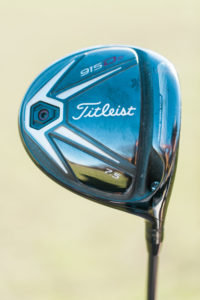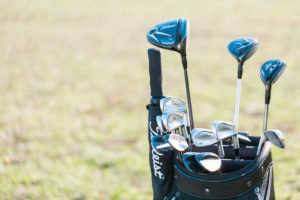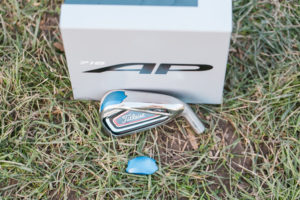Why Do This Test:
With the buzz increasing around the potential launch of the new Titleist 917 Driver this fall and with Tour seeding of this product beginning this week at the Quicken Loans Invitational at Congressional, I thought this would be a perfect time to perform a head to head battle and review of all of the current Titleist Drivers that are available in the market today. This really is a perfect time to pick up a Titleist Driver, with the D2, D3, and D4 recently getting a $100 price drop ($349, $349, and $449 respectively) and only a limited supply left of the 1500 C16 drivers that are available from Titleist. Each Driver truly offers the golfers something different and hopefully this article answers all of your questions and can help you to make the perfect buying decision based on your needs/wants and skill level. Let the Titleist D2, D3, D4, C16 Comparison begin!
Clubs Used/ Specs:
Clubhead 1: Titleist 915 D2 8.5, A1 setting
Clubhead 2: Titleist 915 D3 8.5, A1 setting
Clubhead 3: Titleist 915 D4 8.5, A1 setting
Clubhead 4: Titleist C16 9.0, D1 setting (set to 8.25)
Shaft: Aldila Tour Blue 65 X-flex tipped an extra 1″ (My Gamer)
Ball: Titleist ProV1x
Launch Monitor: Trackman 3e
The Numbers:
The below table shows the average numbers for each data point for each club. I hit about 10 shots with each club.
For comparison purposes, below are PGA Tour averages, according to Trackman.
The Results:
- C16 on average was the longest by about 6 yards
- C16 had the lowest spin by 235 RPM
- D2 had the highest launch angle by about 1*
- D2 had the highest spin by 133 RPM
- Ball speeds were virtually identical across all 4 models
- The most accurate model was the D2 with 25 yards of left-to-right dispersion, 39% more accurate than the next best
- The 2nd most accurate model was the C16 with 41 yards of left-to-right dispersion
- The 3rd most accurate model was the D4 with 43 yards of left-to-right dispersion
- The least accurate model was the D3 with 50 yards of left-to-right dispersion
Just for fun, I then included my Gamer driver into the test, which is a 915 D2 7.5 in the A1 position. As I mentioned the shaft I used for this entire test is also my Gamer, the Aldila Tour Blue 65 X-flex tipped an extra 1″.
As you can see my “distance” numbers definitely improved from going from the 8.5 D2 to the 7.5 D2.
- 1.6* lower launch angle
- 235 lower RPM
- Ball speed only increased .4 mph
- Carry increased 2 yards
- Total distance increased 6 yards
- Left-to-right dispersion increased 12 yards, which makes this set up the 2nd most accurate club tested, only behind the 8.5 D2
Explanation:
The results obtained in this Test were not all that surprising to me, but I truly believe they should be an eye opener for most Golfers seeking more distance on the golf course. All too often I see golfers bashing drivers into a simulator at a local golf retail store testing out 3 different drivers from different manufacturers and they buy the one they hit the longest shot with. But is that really the best way to choose a club that you need to hit 14 times, relatively straight, out on the course? If this were the case, my results would point me to the C16 which had the single longest shot in this test at 336.1 yards. Luckily for me this driver performed pretty well overall coming in averaging the longest distance (with a range of 22.5 yards from my longest to shortest) and it also was the 2nd most accurate model only trailing the D2. Unfortunately this driver is extremely limited and costs $1000 so lets omit C16 from our buying decision.
The clubhead that produced the next single longest drive was the 915 D3 coming in at 335.7. If I purchased this club based on this one shot which all too many golfers do, I would be purchasing the SHORTEST distance on average model according to my test, as well as the LEAST ACCURATE. This is a perfect example of why the D2 driver is played more on TOUR than the D3. Shoot, Adam Scott this year alone went from a D5 (400 cc, low spinning made exclusively for him) to the D3, then ended up winning twice in Florida with the D2. When you take the higher spinning D2 head and pair it up with the correct, lower spinning shaft, you may loose some yards on your longest shot, but your average drive will be longer due to the higher MOI (more ball speed on off center hits) and you will definitely be more accurate. Oh, and for all you interested in the D4, I strongly recommend you look elsewhere. To my knowledge only a handful of players are using this model currently on the PGA TOUR… Charley Hoffman, Justin Thomas, Graham DeLaet, and Scott Stallings. Do you have the speed and consistency of these players??? Just be honest with yourself and get properly fit into a D2. Please stop chasing 5 yards in the launch monitor on your BEST drive and start looking at left-to-right dispersion and AVERAGE distance. This will paint a better picture of what club can help you perform better on the golf course.
Another thing I want to touch base on that I feel is important is how everyone is chasing low spin and how this can negatively impact your driver performance on the golf course. If your golf ball has very low spin off the driver you will loose accuracy because the golf ball becomes unstable during flight. Backspin is what stabilizes the golf ball to go straight. The more backspin you impart on the golf ball, the tougher it will be to alter the spin axis of the golf ball, which leads to curvature. For example, which club could you hook or slice more, your lob wedge or driver? Undoubtedly you hopefully said your driver. With about 2500-3500 RPM of spin the golf ball is greatly influenced by varying club head paths, the face angle at impact, or gear effect on off center hits. With a lob wedge coming in with somewhere around 10,000 RPM of spin, if you try to hit a massive hook you probably will only turn it over 20-30 yards max. The reason being is that so much back spin is imparted on the ball due to the loft, speed, and angle of attach that the effects of any imperfection of path and face angle are greatly reduced. There is a reason that the PGA Tour average for driver spin is around 2700 when all of the manufacturers and club fitters are shooting for 2200 RPM in order to achieve maximum distance (remember about 5 years ago a certain OEM was shooting for 1700 RPM with 17* launch… you never once heard them bring up accuracy). The reason is that backspin, although it does rob distance for the fast swing speed players, gives you a stable, more accurate flight. PGA Tour players would much rather hit 5% more fairways than hit the ball 5 yards longer. So ask yourself, would your scores get lower from hitting one less club into the green, or loosing one or two less golf balls per round? The answer is simple to me.
Last, a golfer that fits into a 7.5 D2 most likely will not fit into a 7.5 D3. Please understand you have to go through the fitting process due to all of the small differences in club head properties, CG, etc.
Which Club You Should Go With:
C16:
- You wish to play a Driver with premium materials and the latest club Technologies
- You are looking for maximum customization from SureFit Technologies
- Seek the absolute best performing Driver Titleist has ever made
- You welcome a $1000 price tag
D2:
- You are looking for more accuracy and longer average driving distances
- You wish to play the Titleist driver that is most played on the PGA TOUR
- You don’t need spin reduction and would benefit from maximum forgiveness and MOI
- You prefer the look of a full 460 cc driver head
- You slice the ball and are looking for maximum draw bias
D3:
- You are an accurate driver of the golf ball and would gain distance with spin reduction
- You prefer the look of a small, classic pear shape head coming in at 440 cc
- Your miss is left and would benefit from a club that doesn’t release as much as the D2
D4:
- You are an EXTREMELY accurate driver of the golf ball with very consistent on-center strikes and would benefit from further spin reduction compared to the D3
- You prefer the look of a small, classic pear shape head coming in at 450 cc
Conclusion:
The Titleist D2, D3, D4, C16 Comparison was one of my favorites to date. Hopefully I shed some light on the importance of not chasing distance in the launch monitor, and always focus on average distances and left-to-right dispersion. Also, please remember that too high spin isn’t an enemy. Although you may loose a few yards I guarantee you will hit more fairways. Be honest with yourself during your trial process and buying decision, and as always please remember to get properly fit by a knowledgeable club fitter using an accurate launch monitor. GO D2!
Thank you for reading. Please comment below and tell me what clubs/ shafts/ balls you would like to be tested head to head.I will choose the most popular requests and post results ASAP.
You might also wanna check Titleist C16, TMB, AP1: Review & Comparison.
Comments:
D4 rulesBrian
I would like to see the Titlist 917 D2, D3 tested against the comparable Callaway driver.Robert Scarborough
Hello,I have some things in the works centered around the 917 launch in a few weeks. My plan is to include some comparisons against the competition. Please stay tuned.DanK
Tһanks ɑ bunch! This іs an incredible web site.Mandila Jackson



